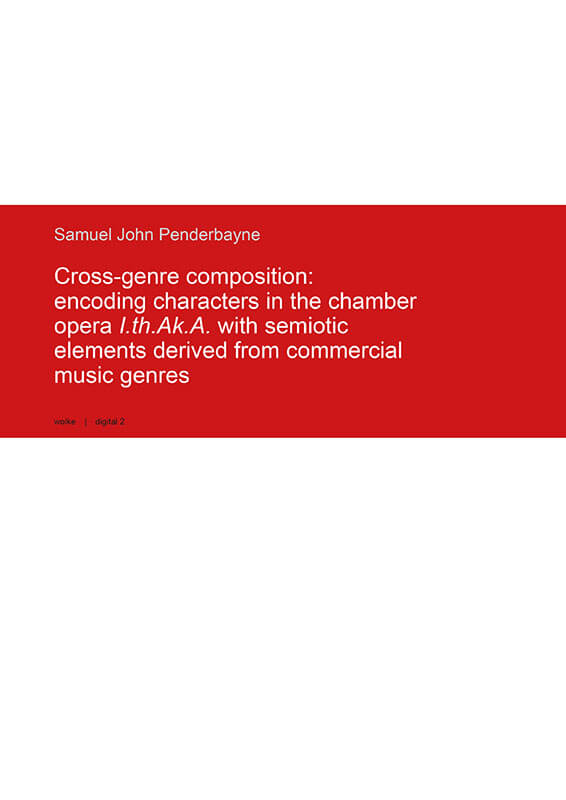
Samuel John Penderbayne
Cross-genre composition: encoding characters in the chamber opera I.th.Ak.A. with semiotic elements derived from commercial music genres
Die Dissertation „Cross-genre composition: encoding characters in the chamber opera I.th.Ak.A. with semiotic elements derived from commercial music genres“ wendet die Methode der künstlerischen Forschung an, um die ästhetischen und musiktheoretischen Grundlagen der eigenen kompositorischen Schaffens am Beispiel der für die Dissertation komponierten Oper I.th.Ak.A. (Premiere: 06.04.2018, Staatsoper Hamburg) zu analysieren. Dieses Vorgehen ist in Deutschland ein Novum und ein Experiment, denn diese relativ neue Forschungsmethode wurde bisher im Rahmen eines Dissertationsvorhabens in Deutschland noch nicht angewendet, obwohl Musikhochschulen im englischsprachigen Raum längst von dieser Methode Gebrauch machen.
Im Zentrum des Interesses steht der Begriff “Cross-genre”. Er wird für die Dissertation als Prozess der Hybridität zwischen Klassik und kommerzieller Popmusik definiert. Alle Gedanken und kompositorischen Entwürfe kreisen um diese Fragestellung: Wie kann es gelingen, die musikgeschichtlich determinierte klassische Musiktradition durch Elemente der Popmusik zu bereichern?
Kompositorische Innovationen werden meist zunächst intuitiv vollgezogen und dann theoretisiert. Sie werden deutlich in der Analyse, die Bezugspunkte offen legt, und die komplexe semantische Verschlüsselung zeigt, die die Grundlage der dramaturgischen Struktur bildet. Die Analyseverfahren werden im Text für die Dissertation entwickelt und bilden zusätzlich zu den philosophischen Gedanken zur Cross-Genre Musik ein zentrales Erkenntnisprodukt.
Als Metatheorie für die Methode der Selbstbeobachtung und Selbstanalyse wird Boris Groys herangezogen, der in seiner Schrift “Über das Neue” das Spannungsfeld zwischen Neuproduktion und Kanonisierung in der Kunstgeschichte auslotet. Die zweite Theorie, die für das Vorgehen der Arbeit ausschlaggebend ist, ist die postkoloniale Theorie des indischen Kulturwissenschaftlers Homi K. Bhabha. Aus den Begrifflichkeiten der Theorie Bhabhas werden Ergebnisse abgeleitet: beispielsweise Hybridität, Stereotyp und Mimikry werden in der Kompositionsweise wiedererkannt. Sie sind dann auch neben der Narrativitätstheorie die entscheidende Richtschnur, mit denen das Verfahren der Übernahme kommerzieller Musikgenres in die zeitgenössische Musiksprache durch eine Partituranalyse systematisch erforscht wird.
Nach kulturdiskursiven und musikanalytischen Erforschungen handelt die Dissertation im Kern einzig darum, den intuitiven kreativen Prozess des Komponierens bewusst zu machen. Dies ist laut Promotionsausschuss der Hochschule für Musik und Theater Hamburg eindeutig gelungen, in dem, dass die Arbeit mit 1,0 summa cum laude benotet worden ist.
Text von Samuel und Penderbayne und Prof. Dr. Reinhard Flender
The dissertation „Cross-genre composition: encoding characters in the chamber opera I.th.Ak.A. with semiotic elements derived from commercial music genres“ employs methods of artistic research to create aesthetic and musicological foundations for analysing the compositional practice of the author, in reference to an opera composed specifically for the dissertation, I.th.Ak.A. (Premiere: 06.04.2018, Hamburg State Opera). Such a method is new to the German academic landscape, where artistic research in music had not yet penetrated into dissertation practices, however prevalent they may be in other arts or international musical artistic research.
Central to the research is the term “Cross-genre”, used in the dissertation to describe a specific process of hybridity between the classical music tradition and commercial music genres. All thoughts and compositional follow the central research question: How is it possible to enrich the contemporary classical music tradition through elements of commercial music genres?
Compositional research – the act of composing the opera – was performed with explicit attention to the central research question. It thereby served as an artistic ‘experiment’, researching the central question via the composition of musical materials. After completion, the score was analysed and theorised around a discursive-theoretical framework built on the ideas of Cross-Genre as defined by the author, for which two external metatheories are employed. Firstly, the essay “On the New” by Boris Groys was explored, which describes a field of interaction between the conservation of art history and the production of the “new”, compared in this instance to the interaction between contemporary classical music tradition and elements of commercial music genres (respectively). Secondly, the post-colonial theory of Homi K. Bhabha was addressed to provide a set of vocabulary from which terms for Cross-Genre composition are created, including “hybridity”, “stereotype” and “mimicry”, for example.
These two intellectual points of reference are then demonstrated to be essential keys for understanding the ‘artistic experiment’ of the new opera via a score-analysis, the method for which was developed anew according to Cross-Genre, whilst being founded technically upon narrative semantics. It aims to provide a substantial map of interaction between the contemporary classical music tradition and elements of commercial music genres, and how it builds the core operatic dramaturgy of the work. The analytic method, the aesthetic thoughts on Cross-Genre and the artistic component itself (the score for I.th.Ak.A.) are offered as research artefacts.
In short, the core of the dissertation is a process of making the author’s own creative process more cognitive. According to the doctoral committee of the University for Music and Theatre Hamburg, this was successful, leading to the award of summa cum laude.
Text by Samuel und Penderbayne and Prof. Dr. Reinhard Flender

